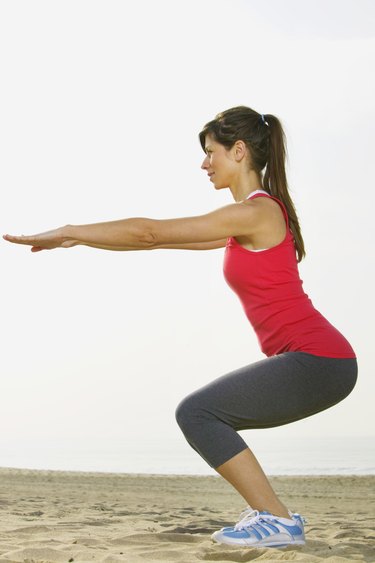
The body weight squat is an effective lower body exercise that targets your hamstrings, quadriceps and gluteus muscles. However, if you perform the squat with incorrect form, you can place undue stress on your lower back or knees. To squat properly, you should stay flat-footed during the squat and not be up on the balls of your feet.
Execution
Video of the Day
To do a body weight squat, stand on a level surface with your feet about hip width apart and your toes pointing forward. Press your hips back and bend your knees to lower your body toward the floor. As you descend, shift your weight back to your heels. Stop when your knees have a 90-degree bend. At this point, your weight should be evenly balanced between your heels and the balls of your feet. Pause for a count and then press through your heels to stand back up.
Video of the Day
Significance
As you descend into a body weight squat, you shift your weight back onto your heels. This shift helps keep your knees from pushing too far forward over your toes. If you shift your weight forward on the balls of your feet, your knees will push forward past your toes. This places undue stress on your knee joints. Although you should not purposefully push your knees forward, they may naturally move forward even if you execute the squat with perfect form. As the American Council on Exercise, or ACE, notes, if you have long limbs, your knees are more likely to move past your toes as your lower leg angles forward to maintain your balance.
Technique
The key to proper squatting form is the hinging of your hips. The squat movement does not originate in the knees; it originates in the hips. Think about sitting down in a chair. Start the squat by unhinging your hips and pressing them back. Your knees will naturally follow. This keeps your weight shifted back to your heels and reduces the forward motion of your knees. If you cannot perform a squat without lifting up on the balls of your feet, you may have a flexibility issue in your lower legs.
Considerations
A triple extension squat involves lifting your heels off the floor at the end of the squat. This is a combination exercise, not a change in the squatting technique. You are adding a calf raise to the squat exercise. You simply perform a regular body weight squat, but once you are in a standing position, shift your weight up on the balls of your feet to execute a calf raise. Slowly lower your heels back to the floor and then initiate your squat descent.